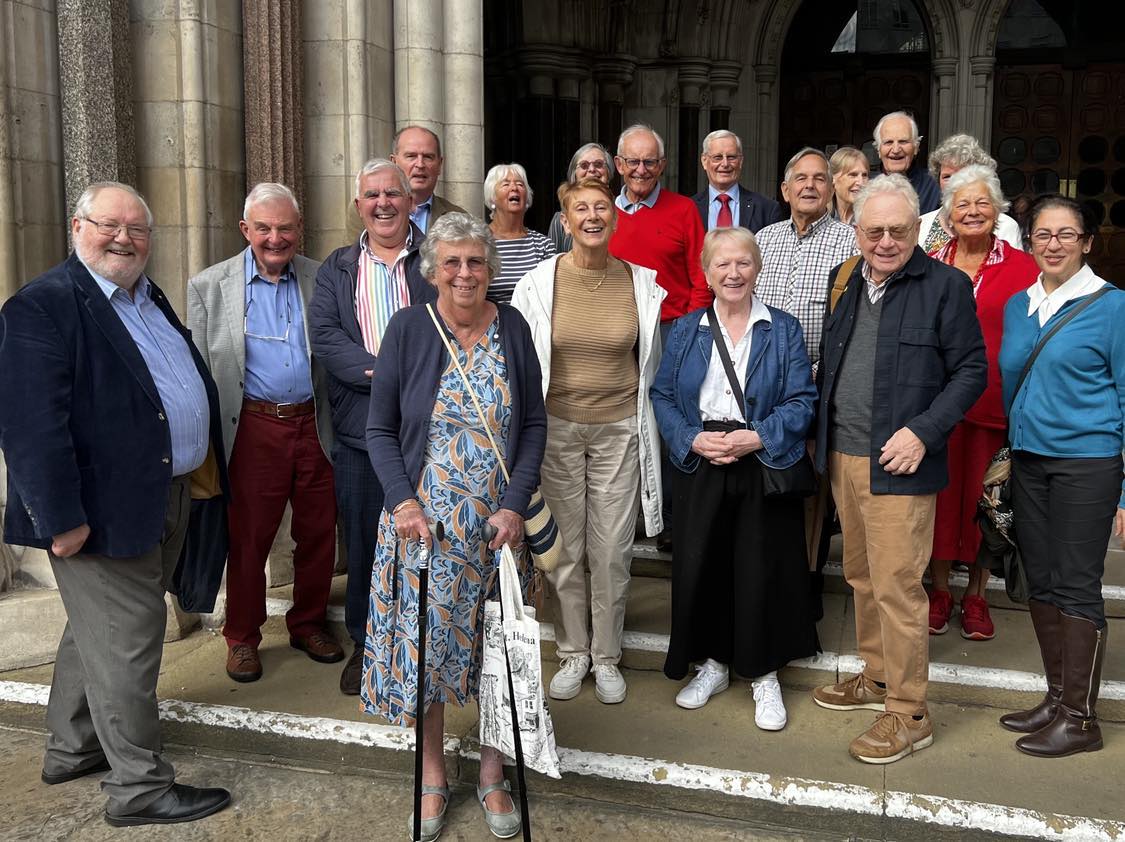
One of the pleasures of being a Rotarian is the opportunity to go on trips and visits to various places around the country. Around 20 Rotarians and guests headed up to London for this particular trip.
Everyone travelled to London following different routes and then met together (after passing security) for the pre-booked tour in the Great Hall of the Law Courts – a huge gothic-style hall with a high, cathedral-like ceiling, large, latticed windows with stained glass, and an intricate Italian-mosaic floor. We were taken on the tour by tour guide Stan who shared lots of facts, figures and anecdotes as he showed us around.
We learnt that the chief architect behind the courts’ design was George Edmund Street, and that the building was opened in 1882 by Queen Victoria. (Stan pointed out a painting showing Queen Victoria at the opening ceremony.) Street, sadly, died before the building was completed – so never saw it as a functioning building.
Since the courts were originally built they have undergone a number of extensions. Currently, there are five buildings – the main one with the grade I Great Hall, the Queen’s Building, and two other blocks. There were corridors and rooms seemingly going off in all directions over several floors. In total there are over 100 courtrooms of different sizes. Curiously, there are said to be around 1,000 rooms in total and 1,000 clocks; another staggering fact is that around 35 million Portland stone blocks were used to create the structure.
Stan took us around various parts of the main building, pointing out architectural features, artworks, or telling us details of key historic individuals as he did so. One particularly ornate room was covered in red green and gold decor and had the coat of arms of the four inns of court (Gray’s Inn, Inner Temple, Lincoln’s Inn and Middle Temple) on its walls.
We learnt some interesting snippets of information during the tour. For instance, when industrial disputes by stone masons had paused work, the stones carvers (who weren’t taking industrial action at the time) were so bored they continued to carve unplanned intricate detail into a couple of columns – until they were stopped from doing so! In another part of the courts, bombed during the Second World War, we saw a couple of remarkable, “fractured” columns that had somehow stayed “intact”.
We learnt that the courts now housed in the buildings are the High Court and the Court of Appeal for England and Wales which are civil, as opposed to criminal courts, and are involved in a number of types of cases – e.g. civil and family court cases and various appeals. Generally, criminal cases don’t take place in the courts – although a backlog of cases due to the pandemic mean a number of cases are now taking place there. Disputes involving large organisations – such as the NHS – are resolved at the courts. The ultimate Court of Appeal used to be the House of Lords but is now the Supreme Court which is located in a new building in Westminster. However, growing numbers of cases are conducted in whole or part online (and the need for such vast courts may be receding into history).
In one part of the building there were a number of judicial gowns on display – the oldest going back to the 1600s. After seeing a group of gowns from across Europe, we learned about the history of judge’s wigs and the current range of wigs used, their care and costs (up to thousands of pounds!)
We learnt that the courts are very expensive to maintain, and that over recent years some new ways of bringing in funds have been explored. This includes hiring parts of the building out for some well-known dramas and Hollywood films – meaning that actors such as Johnny Depp have enjoyed use of the buildings.
Although one can sit in on trials taking place at the court, our tour coincided with lunchtime (during which courts – and courtrooms – are closed). Nevertheless, we were invited to come back at a future date and told where members of the public were able to be seated during a trial.
Everyone gave Stan a warm round of applause as he finished his tour. Sadly, most of us didn’t have time to visit the museum as we were booked for lunch a the nearby Palm Court Brasserie – but we are sure many of us will return for a visit at a later date.
After a delicious and filling lunch, several members visited the National Portrait Gallery before they made their way back home. Interestingly, whereas the Courts in the Strand are Victorian Gothic revival in design (which is based on Byzantine and Arabic principles), the newly re-designed National Portrait Gallery, which has a completely new entrance round the corner from the original, appears to be based on very elegant classical Roman/Greek principles.
Picture: the group pictured on the steps at the entrance to the courts. Picture credit: The Rotary Club of Canterbury. (Photography was strictly forbidden in the building, but we hope to share some pictures of the outside on our Facebook page.)


